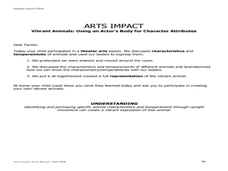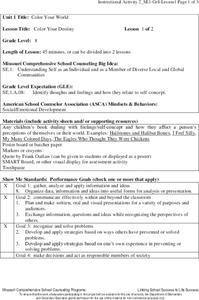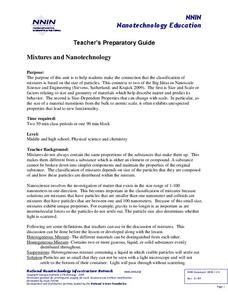Curated OER
Class Rules Contract
First and second graders construct a contract for classroom rules. They define a contract and then choose rules for classroom behavior. Each learner writes these rules down on a class rules contract worksheet (included).
Curated OER
I Wonder What Would Happen if Lots of Manduca Lived in a Small Place...
Students discuss the reasons why humans fight and look for similiarties in animals. They make predictions on what they think will happen when they observe insect crowding. They make conclusions about their predictions to end the lesson...
Curated OER
Ratio and Proportion Problems
What is ratio? What is proportion? Two examples are shown before your pupils are given seven problems using either ratio or proportion. Consider having your learners illustrate a selection of the problems provided.
American Physiological Society
Drug the Water Flea
This is a flea. This is a flea on drugs. Any questions? Your class will have questions aplenty during an impactful experiment. Lab groups get to know Daphnia magna, the humble water flea, and study the effects of stimulants and...
University of New Mexico
Visual Supports for Students with Autism Spectrum Disorder (ASD)
Because autism manifests in so many different ways it is referred to as Autism Spectrum Disorder (ASD). No one approach is appropriate for learners with autism. The idea of this packet if to provide a variety of approaches and materials...
Curated OER
Changing the Grade
How one school took the first few steps in changing the way we viewed our grading approaches and practices.
Memorial Hall Museum
Problems and Events Leading Up To the Attack of 1704
Groups read primary and secondary sources detailing the ambush at Bloody Brook on September 18, 1675 and the attack on The Falls in May of 1676. After examining the results of each attack, groups reflect on the language used in the...
Curated OER
Modern Interpretations
To conclude an eight-lesson study of the events that occurred in the early colonial period in Deerfield, Massachussetss, class members evaluate the point of view and bias found in late 19th and early 20th century retellings.
Curated OER
Understanding the Basics of the Behaviorist Theory
Ideas gleaned from the behaviorist theory may help equip you with classroom management tools.
Bully Free Systems
Bully Free Lesson Plans—Sixth Grade
Two lessons stress the importance of keeping your classroom bully-free. Discussion, collaborative work, role-play, and writing allows participants to examine whether their classroom is welcoming to new members and decide what they should...
Facebook
Online Presence
What happens when an online post gets the wrong kind of attention? Learners evaluate the good, the bad, and the occasionally ugly side of social media posting with a instructional activity from a vast digital citizenship series. After...
Missouri Department of Elementary
If It’s to Be, It’s Up to Me
Here's a clever switch on the tale of Pandora's Box. Rather than lifting the lid and having problems escape, class members write a problem on a strip of paper and place it in Pandora's Problem Box. A student then pulls a problem from...
Sports Museum
Boston vs Bullies: Facilitator's Guide
Score a big win for your school's environment with top-notch bullying prevention resources! The downloadable materials feature prominent sports figures from the Boston area talking about their experiences with bullying. Appropriate for...
American Psychological Association
Counting Fidgets: Teaching the Complexity of Naturalistic Observation
Why do psychologists conduct experiments in controlled laboratory settings? High schoolers gain an understanding of the importance of controls with an activity that involves naturalistic observations with no imposed controls.
Curated OER
Vibrant Animals: Using an Actor's Body for Character Attributes
Students identify and portray specific character attributes through uprigth movement, creating a portrayal of an animal. They use vibrant, upright movement to convey the characteristics and temperament of specific animals. Finally,...
Missouri Department of Elementary
Color Your Destiny
Class groups bring feeling words alive by creating a poster that illustrates with images and colors, but not words, the feeling conjured by the word. The posters are then combined into a mural for the classroom wall.
Simon & Schuster
Curriculum Guide to: Pride and Prejudice by Jane Austen
An 18-page curriculum guide for Jane Austen's Pride and Prejudice consists of five lessons. The first plan asks readers to compare the manners, social behaviors, and class issues in Austen's novel to today's. Next, pupils examine a...
Peace Corps
Brief Encounters
How are Pandyas different than Chispas? Explore cultural norms and societal behaviors with an engaging role-play activity. Split into groups of two hypothetical cultural groups, the formal Pandyas and the sociable Chispas, and another...
Missouri Department of Elementary
Managing Conflicts
Conflicts happen. Learning how to manage conflicts in mature and positive ways is an important part of social-emotion growth. The lesson offers insight into behaviors that exacerbate conflicts as well as suggestions for how to resolve...
Scholastic
Analyzing Media Messages
Telling young people to just say no can be difficult in a world that inundates them with messages to just say yes. A lesson on media messages encourages teenagers to analyze song lyrics and advertisements that mention drugs and/or...
Transforming Education
Self-Efficacy Toolkit
A PowerPoint presentation prepares instructors for teaching learners about self-efficacy, a key competency of social-emotional learning. The 29-page presentation is designed to give administrators and teachers a deeper understanding of...
Baylor College
Food for Kids
Immediately capture the attention of your class with the smell of freshly popped popcorn in the sixth activity of this series on the needs of living things. Young scientists first use their senses to make and record observations of...
National Nanotechnology Infrastructure Network
Mixtures and Nanotechnology
What does size have to do with it? Learners analyze different mixtures, both homogeneous and heterogeneous, to discover the properties related to the size of their particles. The activity connects these properties to those of...
National Nanotechnology Infrastructure Network
Understanding Wave Motion - Slinky vs. Snaky: Which Spring is Dominant?
Ride the wave to an understanding of refraction! The first in a series of two inquiry-based lessons challenges learners to create transverse waves with two different types of springs. As their wave hits an object, they observe the change...

























